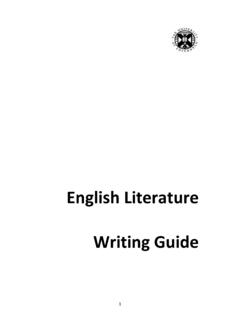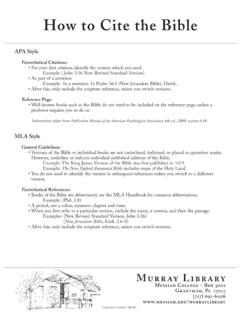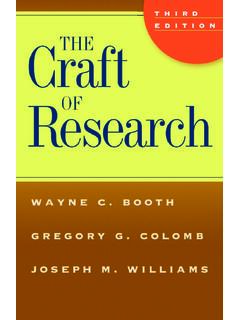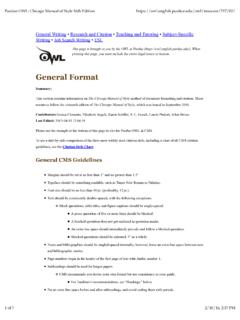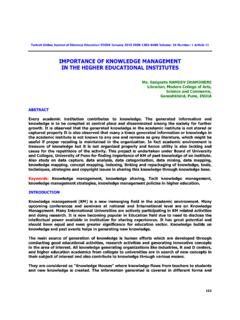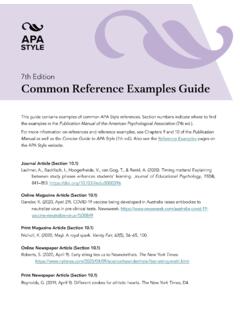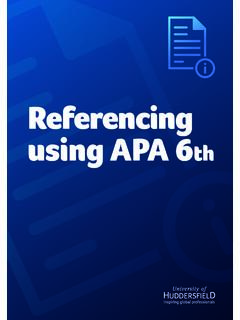Transcription of A Manual for Writers of Research Papers, Theses, and
1 A Manual for Writers of Research Papers, Theses, and dissertations On Writing, Editing, and Publishing Jacques Barzun Tricks of the Trade Howard S. Becker Writing for Social Scientists Howard S. Becker Permissions, A Survival Guide: Blunt Talk about Art as Intellectual Property Susan M. Bielstein The Craft of Translation John Biguenet and Rainer Schulte, editors The Craft of Research Wayne C. Booth, Gregory G. Colomb, and Joseph M. Williams Glossary of Typesetting Terms Richard Eckersley, Richard Angstadt, Charles M. Ellerston, Richard Hendel, Naomi B. Pascal, and Anita Walker Scott Writing Ethnographic Fieldnotes Robert M.
2 Emerson, Rachel I. Fretz, and L. Shaw Legal Writing in Plain English Bryan A. Garner From dissertation to Book William Germano Getting It Published William Germano A Poet's Guide to Poetry Mary Kinzie The Chicago Guide to Collaborative Ethnography Luke Eric Lassiter Doing Honest Work in College Charles Lipson How to Write a BA Thesis Charles Lipson Cite Right Charles Lipson The Chicago Guide to Writing about Multivariate Analysis Jane E. Miller The Chicago Guide to Writing about Numbers Jane E. Miller Mapping It Out Mark Monmonier The Chicago Guide to Communicating Science Scott L.
3 Montgomery Indexing Books Nancy C. Mulvany Getting into Print Walter W. Powell Tales of the Field John Van Maanen Style Joseph M. Williams A Handbook of Biological Illustration Frances W. Zweifel Chicago Style for Students and Researchers Kate L. Turabian Revised by Wayne C. Booth, Gregory G. Colomb, Joseph M. Williams, and University of Chicago Press Editorial Staff The University of Chicago Press Chicago and London 's note: Given the complex formatting of this work, its presentation on an electronic device may differ slightly from the print book. Every care has been taken to ensure that readers of this eBook will be able to navigate the content easily and effectively.
4 Portions of this book have been adapted from The Craft of Research , 2nd edition, by Wayne C. Booth, Gregory G. Colomb, and Joseph M. Williams, 1995, 2003 by The University of Chicago; and from The Chicago Manual of Style, 15th edition, 1982, 1993, 2003 by The University of Chicago. The University of Chicago Press, Chicago 60637 The University of Chicago Press, Ltd., London 2007 by The University of Chicago All rights reserved. Published 2007 Printed in the United States of America 16 15 14 13 12 11 10 09 08 07 1 2 3 4 5 ISBN-13: 978-0-226-82338-6 (electronic) ISBN-13: 978-0-226-82336-2 (cloth) ISBN-13: 978-0-226-82337-9 ( paper ) ISBN-10: 0-226-82336-9 (cloth) ISBN-10: 0-226-82337-7 ( paper ) Library of Congress Cataloging-in-Publication Data Turabian, Kate L.
5 A Manual for Writers of Research papers, theses, and dissertations : Chicago style for students and researchers / Kate L. Turabian; revised by Wayne C. Booth, Gregory G. Colomb, Joseph M. Williams, and University of Chicago Press editorial staff. 7th ed. p. cm. Portions of this book have been adapted from The Craft of Research , 2nd edition, by Wayne C. Booth, Gregory G. Colomb, and Joseph M. Williams, 1995, 2003 by The University of Chicago; and from The Chicago Manual of Style, 15th edition, 1982, 1993, 2003 by The University of Chicago.
6 Includes bibliographical references and index. ISBN-13: 978-0-226-82336-2 (cloth : alk. paper ) ISBN-13: 978-0-226-82337-9 (pbk. : alk. paper ) ISBN-13: 978-0-226-82338-6 (electronic) ISBN-10: 0-226-82336-9 (cloth : alk. paper ) ISBN-10: 0-226-82337-7 (pbk. : alk. paper ) 1. Dissertations, Academic Handbooks, manuals, etc. 2. Academic writing Handbooks, manuals, etc. I. Title. 2007 dc22 2006025443 The paper used in this publication meets the minimum requirements of the American National Standard for Information Sciences Permanence of paper for Printed Library Materials, ANSI Contents A Note to Students Preface Acknowledgments Part I Research and Writing: From Planning to Production Wayne C.
7 Booth, Gregory G. Colomb, and Joseph M. Williams Overview of Part I 1 What Research Is and How Researchers Think about It How Researchers Think about Their Aims Three Kinds of Questions That Researchers Ask 2 Moving from a Topic to a Question to a Working Hypothesis Find a Question in Your Topic Propose Some Working Answers Build a Storyboard to Plan and Guide Your Work Organize a Writing Support Group 3 Finding Useful Sources Understand the Kinds of Sources Readers Expect You to Use Record Your Sources Fully, Accurately, and Appropriately Search for Sources Systematically Evaluate Sources for Relevance and Reliability Look beyond the Usual Kinds of References 4 Engaging Sources Read Generously to Understand.
8 Then Critically to Engage and Evaluate Take Notes Systematically Take Useful Notes Write as You Read Review Your Progress Manage Moments of Normal Panic 5 Planning Your Argument What a Research Argument Is and Is Not Build Your Argument around Answers to Readers' Questions Turn Your Working Hypothesis into a Claim Assemble the Elements of Your Argument Distinguish Arguments Based on Evidence from Arguments Based on Warrants Assemble an Argument 6 Planning a First Draft Avoid Unhelpful Plans Create a Plan That Meets Your Readers' Needs File Away Leftovers 7 Drafting Your Report Draft in the Way That Feels Most Comfortable Develop Productive Drafting Habits Use Your Key Terms to Keep Yourself on Track Quote, Paraphrase.
9 And Summarize Appropriately Integrate Quotations into Your Text Use Footnotes and Endnotes Judiciously Interpret Complex or Detailed Evidence before You Offer It Be Open to Surprises Guard against Inadvertent Plagiarism Guard against Inappropriate Assistance Work through Chronic Procrastination and writer 's Block 8 Presenting Evidence in Tables and Figures Choose Verbal or Visual Representations Choose the Most Effective Graphic Design Tables and Figures Communicate Data Ethically 9 Revising Your Draft Check Your Introduction, Conclusion, and Claim Make Sure the Body of Your Report Is Coherent Check Your Paragraphs Let Your Draft Cool.
10 Then Paraphrase It 10 Writing Your Final Introduction and Conclusion Draft Your Final Introduction Draft Your Final Conclusion Write Your Title Last 11 Revising Sentences Focus on the First Seven or Eight Words of a Sentence Diagnose What You Read Choose the Right Word Polish It Off Give It Up and Print It Out 12 Learning from Your Returned paper Find General Principles in Specific Comments Talk to Your Instructor 13 Presenting Research in Alternative Forums Plan Your Oral Presentation Design Your Presentation to Be Listened To Plan Your Poster Presentation Plan Your Conference Proposal 14 On the Spirit of Research Part II Source Citation 15 General Introduction to Citation Practices Reasons for Citing Your Sources The Requirements of Citation Two Citation Styles Citation of Electronic Sources Preparation of Citations A Word on Citation Software 16 Notes-Bibliography Style: The Basic Form Basic Patterns Bibliographies Notes Short Forms for Notes 17 Notes-Bibliography Style.

